
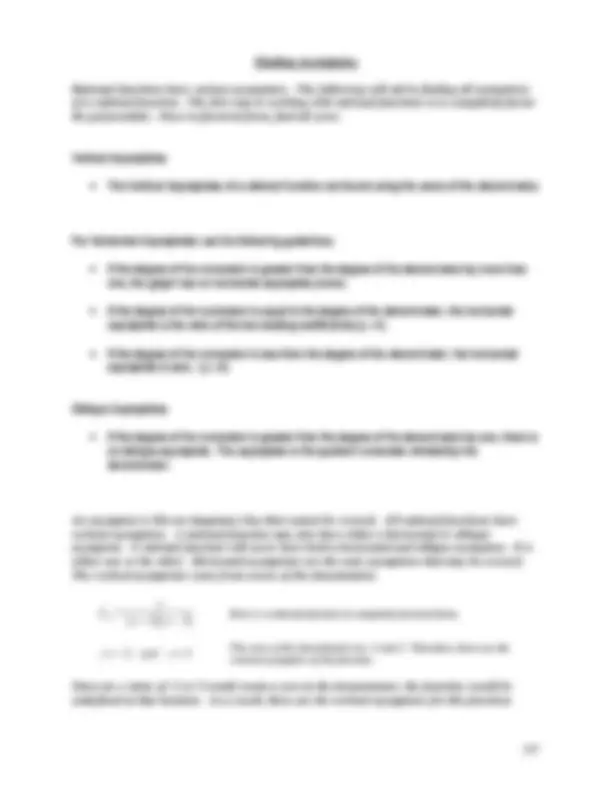
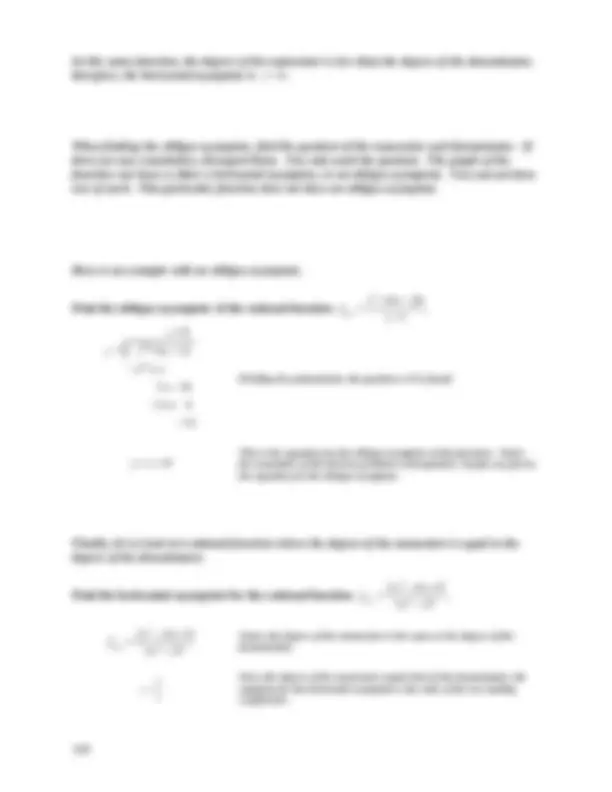

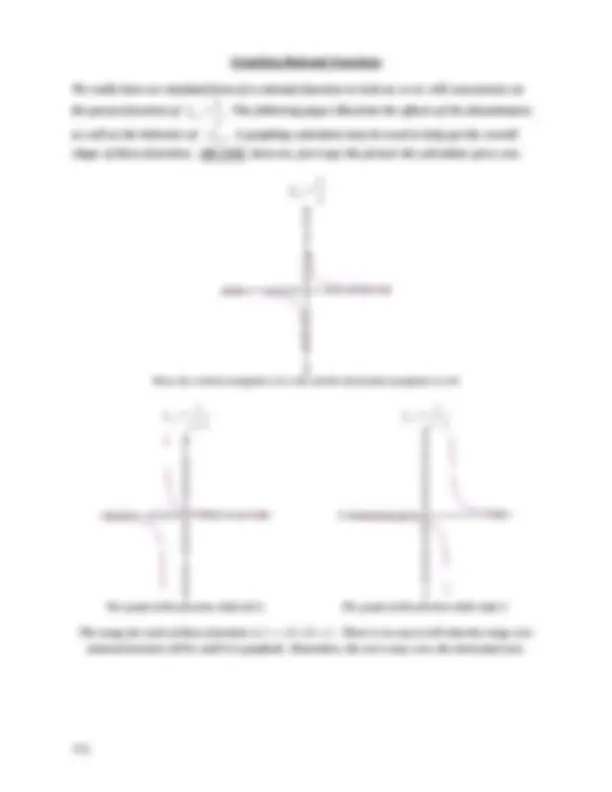
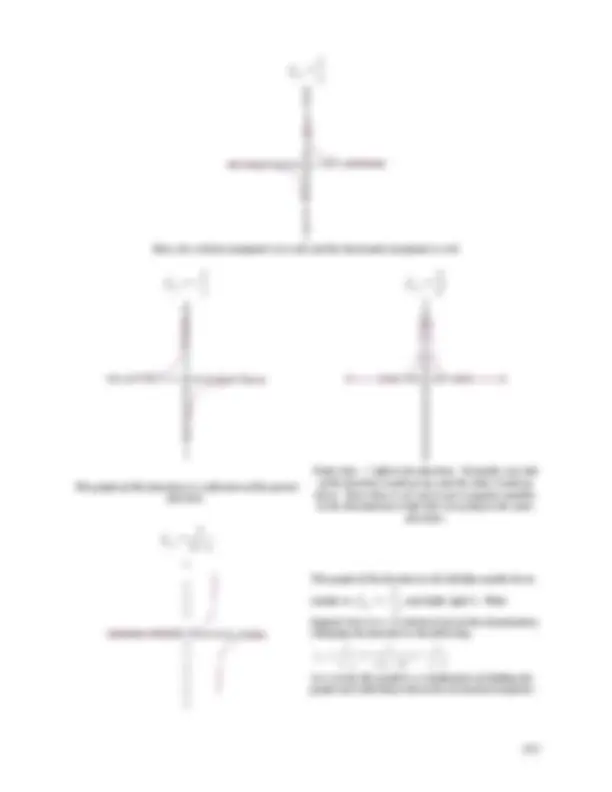
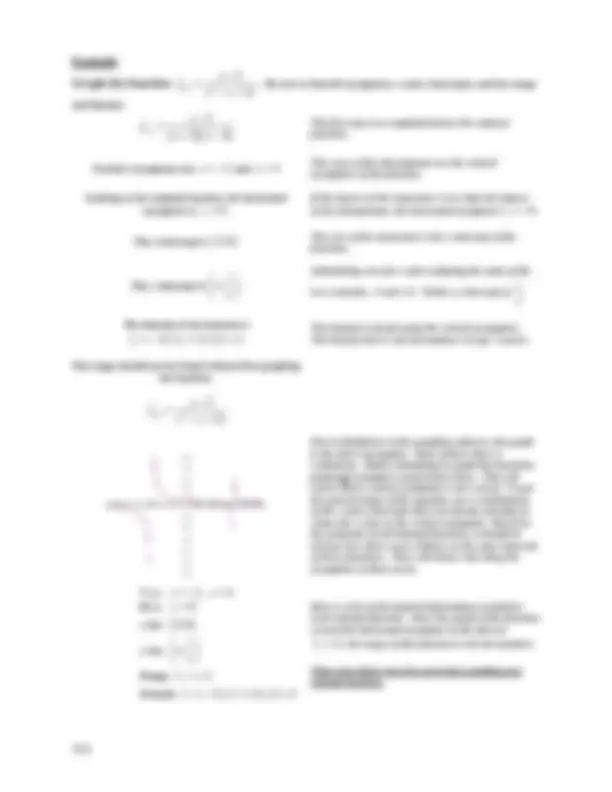





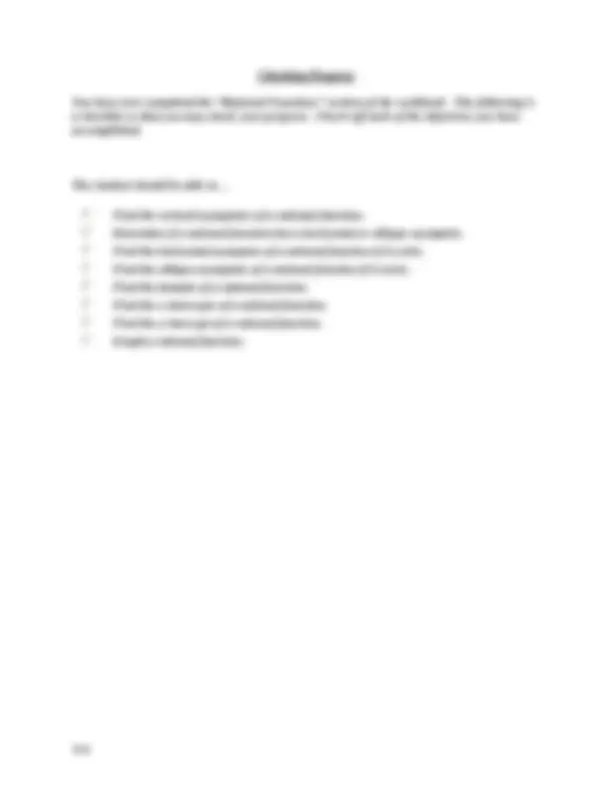


Study with the several resources on Docsity

Earn points by helping other students or get them with a premium plan


Prepare for your exams
Study with the several resources on Docsity

Earn points to download
Earn points by helping other students or get them with a premium plan
Community
Ask the community for help and clear up your study doubts
Discover the best universities in your country according to Docsity users
Free resources
Download our free guides on studying techniques, anxiety management strategies, and thesis advice from Docsity tutors
The domain of a rational function is found using only the vertical asymptotes. As previously noted, rational functions are undefined at vertical asymptotes. ...
Typology: Study notes
1 / 20

This page cannot be seen from the preview
Don't miss anything!













- Finding Asymptotes…………………………………………….. Objectives
The following is a list of objectives for this section of the workbook.
By the time the student is finished with this section of the workbook, he/she should be able to…
Math Standards Addressed
The following state standards are addressed in this section of the workbook.
Algebra II
3.0 Students are adept at operations on polynomials, including long division.
4.0 Students factor polynomials representing the difference of squares, perfect square trinomials, and the sum and difference of two cubes.
7.0 Students add, subtract, multiply, divide, reduce, and evaluate rational expressions with monomial and polynomial denominators and simplify complicated rational expressions, including those with negative exponents in the denominator.
8.0 Students solve and graph quadratic equations by factoring, completing the square, or using the quadratic formula. Students apply these techniques in solving word problems. They also solve quadratic equations in the complex number system.
15.0 Students determine whether a specific algebraic statement involving rational expressions, radical expressions, or logarithmic or exponential functions is sometimes true, always true, or never true.
Mathematical Analysis
6.0 Students find the roots and poles of a rational function and can graph the function and locate its asymptotes.
In this same function, the degree of the numerator is less than the degree of the denominator, therefore, the horizontal asymptote is y = 0.
When finding the oblique asymptote, find the quotient of the numerator and denominator. If there are any remainders, disregard them. You only need the quotient. The graph of the function can have a either a horizontal asymptote, or an oblique asymptote. You can not have one of each. This particular function does not have an oblique asymptote.
Here is an example with an oblique asymptote.
Find the oblique asymptote of the rational function (^) ( )
x 1
x x f x
Dividing the polynomials, the quotient x+9 is found.
y = x + 9
This is the equation for the oblique asymptote of the function. Notice the remainder of the division problem is disregarded. It plays no part in the equation for the oblique asymptote.
Finally, let us look at a rational function where the degree of the numerator is equal to the degree of the denominator.
Find the horizontal asymptote for the rational function (^) ( )
2 2
x 3 27
x x f x
( )
2 2
x 3 27
x x f x
Notice the degree of the numerator is the same as the degree of the denominator.
2 3
y =
Since the degree of the numerator equals that of the denominator, the equation for the horizontal asymptote is the ratio of the two leading coefficients.
Find all asymptotes of the following functions. (Do not graph these)
A) (^) ( )
x 5
x f x
x 2 f x
2 x 5
x f x
x 1
x x f x
2 2
x 2 18
x x f x
x 2
x x f x
x 3 f x
2 4
x 81
x f x
3 2 2
x
x x f x
Finding Intercepts
We have found that the zeros of the denominator of a rational function are the vertical asymptotes of the function. The zeros of the numerator on the other hand, are the x intercepts of the function.
Find all x and y intercepts of the function (^) ( )
x 1
x f x
( )
x 1
x x f x
Write out the function in completely factored form.
Now, find the zeros of the numerator x = − 3 and x = 3 These are the x intercepts of the function.
Look at the original function.
( )
x 1
x f x
From here, substitute zero for x, and find the y intercept, which in this case will be the ratio of the two constants.
y = 9
This is the y intercept of the function. In this case, it is the ratio of the two remaining constants once zero is substituted in for x. If there is no constant in the denominator, then there will be no y intercept as x=0 is a vertical asymptote and the graph is undefined at the y axis.
As demonstrated above, the y intercept of a rational function is the ratio of the two constants. Like always, substitute zero for x, and solve for y to find the y intercept.
Find the x and y intercepts of each rational function.
x 5
x f x
x 4 f x
2 x 5
x f x
x 1
x x f x
x 12
x f x x x
3 x (^2 7 )
x f x x
Graphing Rational Functions
We really have no standard form of a rational function to look at, so we will concentrate on
the parent function of (^) ( )
f (^) x = (^) x. The following pages illustrate the effects of the denominator,
as well as the behavior of − f ( x ). A graphing calculator may be used to help get the overall
shape of these functions. DO NOT, however, just copy the picture the calculator gives you.
( )
f (^) x = x
Here, the vertical asymptote is at x=0, and the horizontal asymptote is y=0.
( )
1 2
f (^) x x
=
( )
1 2
f (^) x x
= −
The graph of this function shifts left 2. The graph of this function shifts right 2.
rational function will be until it is graphedt. Remember, the curve may cross the horizontal axis.
Example
Graph the function (^) ( ) 2
x 12
x f x x
. Be sure to find all asymptotes, x and y intercepts, and the range
and domain.
( )
x 3 4
x f x x
The first step is to completely factor the rational function.
Vertical Asymptotes are x = − 3 and x = 4 The zeros of the denominator are the verticalasymptotes of the function.
Looking at the original function, the horizontal asymptote is y = 0.
If the degree of the numerator is less than the degree of the denominator, the horizontal asymptote is y = 0.
The y intercept is 1 0, 4
.
Substituting zero for x and evaluating the ratio of the two constants, -3 and -12. Yields a y intercept of 1 4
.
The domain of the function is
The domain is found using the vertical asymptotes. The domain here is all real numbers except -3 and 4.
The range should not be found without first graphing the function.
( ) 2
x 12
x f x x
Due to limitations in the graphing software, the graph to the left is incomplete. Each of these lines is continuous. Before attempting to graph the functions, graph all asymptotes using broken lines. This will ensure that a vertical asymptote is not crossed. To get the general shape of the equation, use a combination of the x and y intercepts that were found, and plug in values for x close to the vertical asymptote. Based on the properties of all rational functions, it should be obvious how these curves behave on the outer intervals of these functions. They will always ride along the asymptotes in these areas.
V.A.: x = − 3 , x = 4 H.A.: y = 0
y-int:
1 0, 4
Here is a list of all required information needed for each rational function. Since the graph of the function crossed the horizontal asymptote in the interval
These procedures must be used when graphing any rational function.
Match the appropriate graph with its equation below. Explain why each of the solutions is true. A B C
f (^) x = (^) x 2) (^) ( )
x 3 f x
f (^) x x
x 2 f x
2 x 1
x f x
f (^) x 1 x
x 2 f x
x 2
x f x
x 3 9
x f x
x
x f x
2 2
x 4
x f x
3 x (^2 )
x f x
x 2
x f x
x
x f x
2
f (^) x x
f (^) x x
Checking Progress
You have now completed the “Rational Functions” section of the workbook. The following is a checklist so that you may check your progress. Check off each of the objectives you have accomplished.
The student should be able to…
Find the vertical asymptotes of a rational function. Determine if a rational function has a horizontal or oblique asymptote. Find the horizontal asymptote of a rational function if it exists. Find the oblique asymptote of a rational function if it exists. Find the domain of a rational function. Find the x intercepts of a rational function. Find the y intercept of a rational function. Graph a rational function.